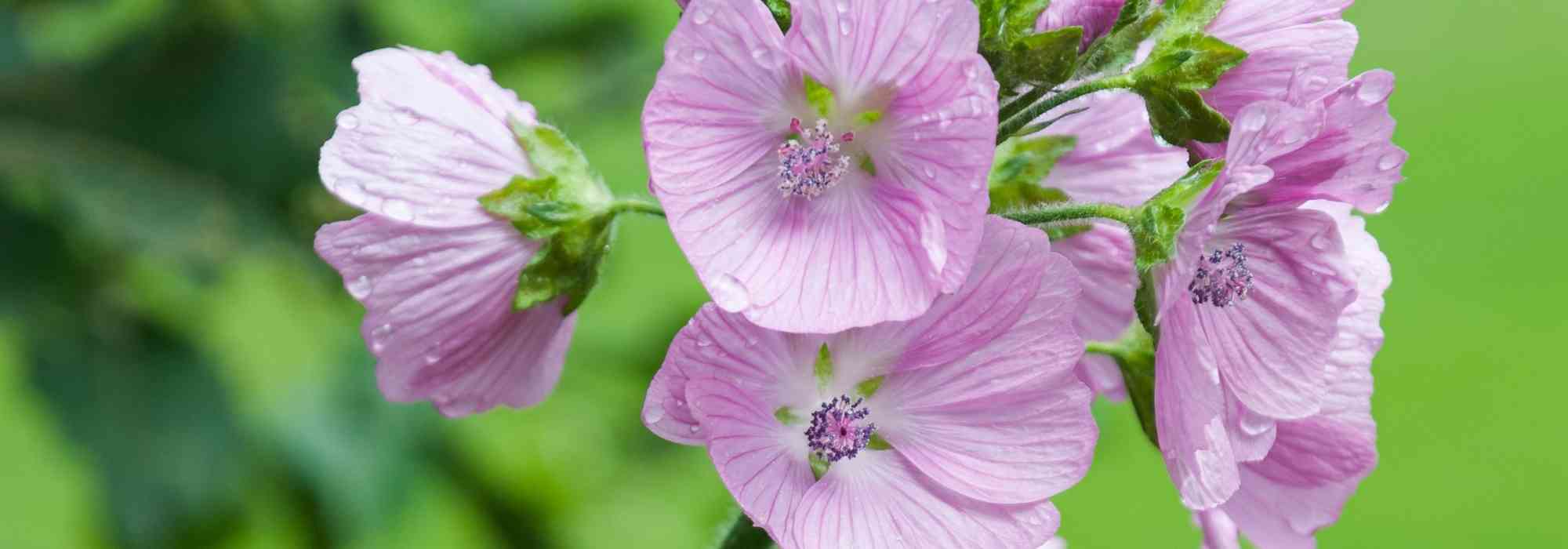
Sidalcea: planting, growing
Contents
Sidalcea in a nutshell
- Sidalcea is a lovely summer perennial, a cousin of mallows, resembling a miniature hollyhock!
- It offers an elegant pink or white flowering throughout the summer, with remarkable freshness.
- Hardy and easy to care for, it thrives in consistently moist but well-drained soil and a sunny position.
- Stunning, it works wonders in borders, flower beds, and pots!
- It is ideal for cottage gardens, romantic borders, and in a garden with a wild appearance.
A word from our expert
Less well-known than its cousin the mallow, Sidalcea or Checkerbloom is a delightful perennial that forms a charming flowering bush throughout the summer. It creates upright clumps adorned with a lovely summer flowering of spikes bearing pastel pink or white flowers.
From Sidalcea ‘Little Princess’ with its pale pink flowers, to ‘Party Girl’ in lavender pink, and Sidalcea oregana ‘Brilliant’ in carmine pink, all are highly floriferous from July to August.
This “prairie mallow” deserves a place in our gardens to abundantly flower in summer borders or mixed borders. Its elegant and natural appearance suits cottage gardens where it easily self-seeds.
Low-maintenance, it thrives in full sun or light shade in any good garden soil that is not too dry in summer.
Hardy, resilient, and boasting a generous summer flowering with a rustic charm, Sidalcea has everything to please!
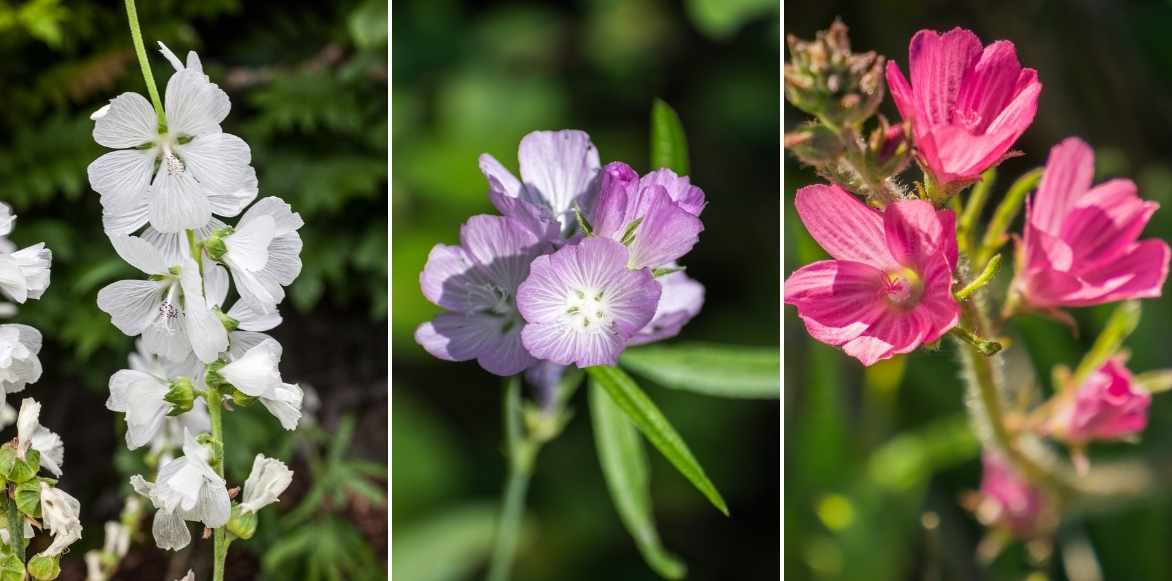
Sidalcea candida (Photo: Peganum), Sidalcea oregana, Sidalcea malviflora
Description and botany
Botanical data
- Latin name Sidalcea
- Family Malvaceae
- Common name checkerbloom, prairie mallow
- Flowering July to August
- Height 0.45 to 0.80 m
- Exposure Sun, Partial shade
- Soil type well-drained, moist
- Hardiness -15°C
Checkerbloom (Sidalcea in Latin), sometimes called “prairie mallow”, is a herbaceous perennial belonging to the mallow family, just like hollyhocks, common mallow, and marshmallow, with which it is closely related. The genus Sidalcea comprises about 25 species native to the prairies, stream banks, and clearings of the northwestern United States, the most well-known being Sidalcea candida, a species with white flowers, Sidalcea oregana, and Sidalcea malviflora. These species have given rise to numerous hybrid cultivars.
From a woody taproot, the plant develops into a bushy tuft with an erect habit, which is characteristic of mallows. The height of this bush with stiff stems varies from 40 to 80 cm depending on the varieties, with a spread of about 35 cm. The habit is more or less compact depending on the cultivars.
Its rapid growth is matched only by the brevity of its life: it is a short-lived perennial (generally 3 to 4 years) that can behave like a biennial, but ensures its longevity through numerous spontaneous sowings, provided the soil is suitable.
The tall, upright, cylindrical, stiff, and hairy stems emerging from the base bear deciduous leaves. The basal foliage consists of large, dentate leaves that are wider than long, lobed, while the stem leaves taper, becoming smaller and narrower, linear. Rounded, they are often palmate, resembling maple leaves, divided into lobes with bases that are sometimes kidney-shaped (reniform). Their colour is a beautiful bright to dark green.
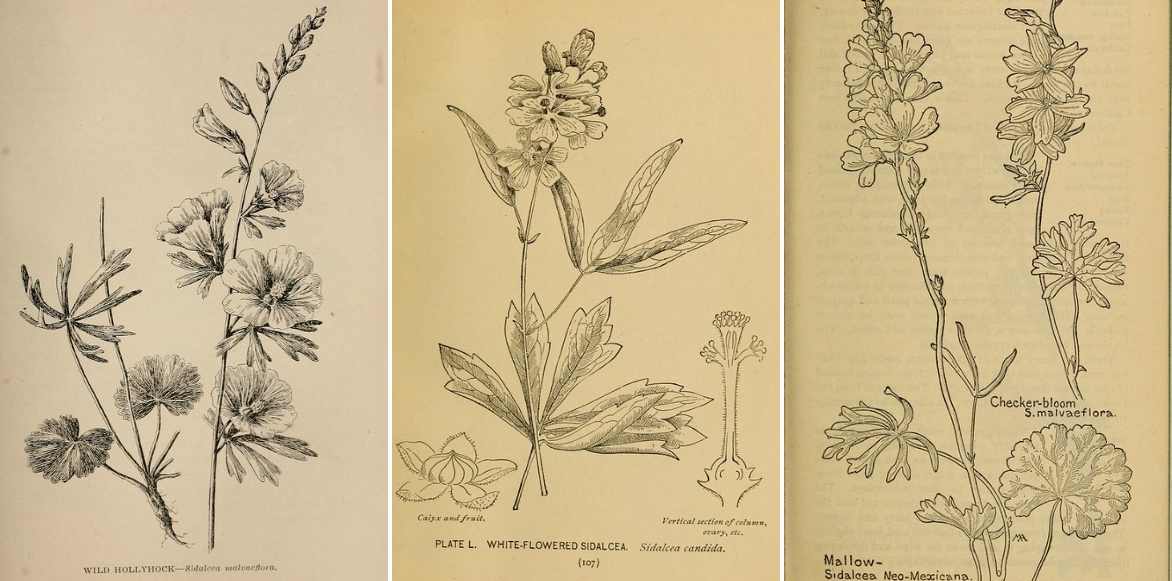
Sidalcea malviflora (1902), Sidalcea candida (1899), and Sidalcea neo-mexicana (1915)
From this beautifully cut foliage, solid and unbranched flower spikes emerge. From July to August, the plant flowers in the form of terminal spikes adorned with numerous small flowers arranged along the slender stems. All bloom from the bottom to the top. The flower buds open into wide corollas measuring 2 to 5 cm across, reminiscent of those of mallows or miniature hollyhocks. They consist of 5 oval, satin-like petals with fringed edges, set in a pubescent calyx. They are marked with a white centre from which a bouquet of well-visible stamens emerges, gathered into a central column.
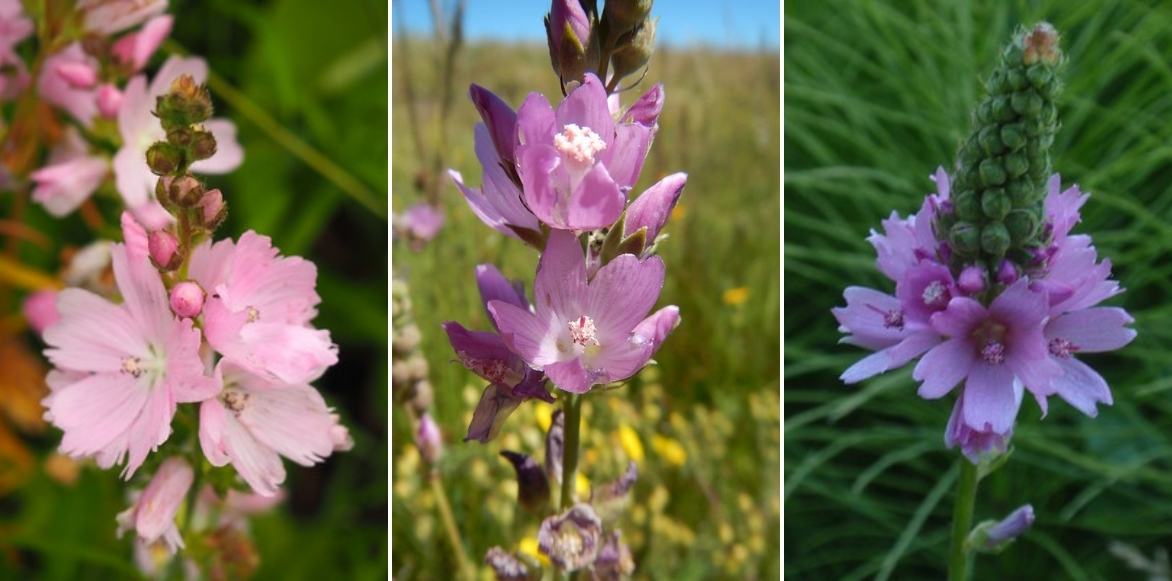
Sidalcea ‘Elsie Hugh’ (Photo: T. Grau Ros), Sidalcea oregana in full bloom (Photo: M. Lavin), Sidalcea oregana starting to bloom from the bottom (Photo: T. Hilton)
Each variety reveals a unique colour. Most often mauve, the flowers are lavender pink in ‘Party Girl’, delicately satin pink in ‘Elsie Heugh’ and ‘Little Princess’, carmine pink in ‘Brilliant’, and sometimes white as in Sidalcea candida. These delicate and satin-like corollas are sometimes so subtly veined that they appear bicoloured.
In summer, this multitude of small nacreous cups attracts pollinating insects. Although unscented, they more than compensate for this lack of fragrance with their remarkable floriferousness. They are perfect for creating lovely bouquets that are as ephemeral as they are rustic.
After fertilization, they give way to small fruits containing seeds that will self-sow wherever they please.
“`
Main species and varieties

Sidalcea Little Princess
- Flowering time August, September
- Height at maturity 45 cm
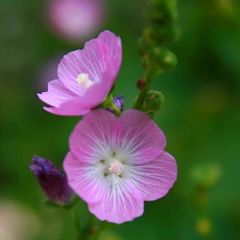
Sidalcea Party Girl
- Flowering time August, September
- Height at maturity 80 cm

Sidalcea oregana Brilliant
- Flowering time August, September
- Height at maturity 70 cm
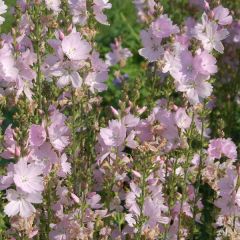
Sidalcea malviflora Elsie Heugh
- Flowering time August, September
- Height at maturity 80 cm
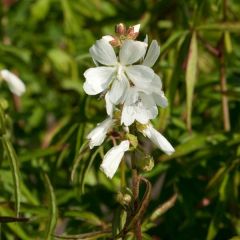
Sidalcea candida
- Flowering time August, September
- Height at maturity 80 cm
Discover other Sidalcea - Checker Bloom
View all →Available in 3 sizes
Available in 1 sizes
Available in 1 sizes
Available in 2 sizes
Available in 1 sizes
Available in 3 sizes
Available in 1 sizes
Planting Sidalcea
Where to plant it?
Very hardy (down to -15°C), Sidalcea can be grown throughout France, although it may behave as a biennial in harsh climates. Give it a well-sunny spot. Avoid overly hot or dry conditions; in the south, it will tolerate partial shade. Easy to care for, it adapts to any good garden soil, rich and light, preferably loamy or sandy, cool, and not too calcareous. The soil must be well-drained, as it is sensitive to stagnant moisture in waterlogged soils, which can shorten its lifespan.
Compact in nature, it won’t hinder neighbouring plants and will quickly form a graceful, floriferous bush.
With its light and natural silhouette, it fits well in cottage gardens, naturalistic gardens, and vicarage gardens, bringing freshness to the heart of summer. It adds elegance and poetry to flower beds, cool rockeries, and along the edges of perennial borders. Some compact varieties are also perfect in pots on the terrace.
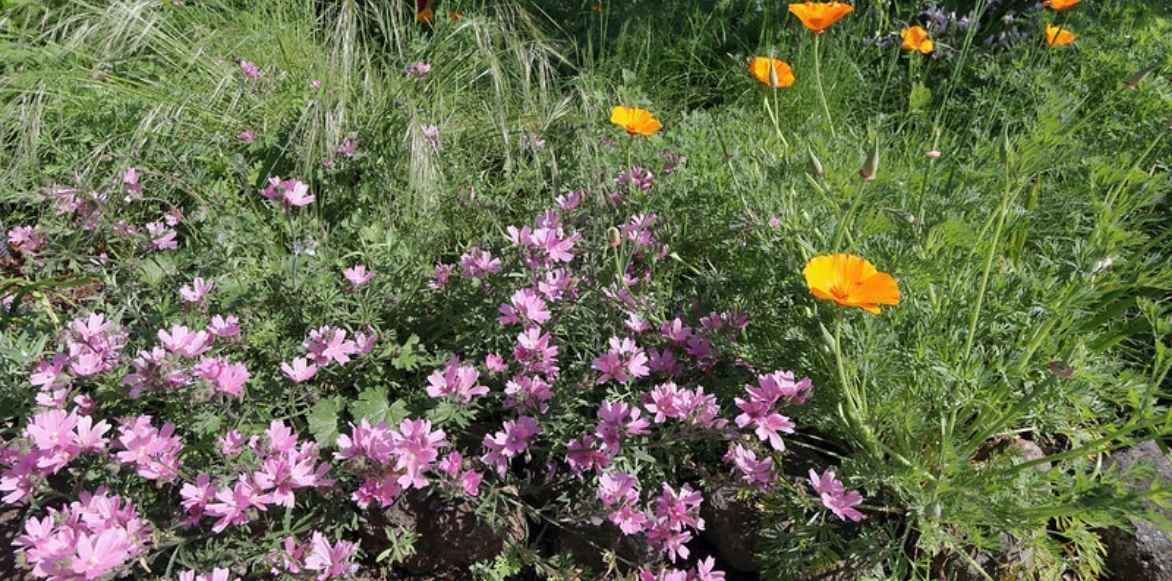
Sidalcea malviflora alongside California Poppies (Photo: J. Kehoe)
When to plant it?
Our Sidalcea can be planted from March to May after the last frosts or from September to November.
How to plant it?
In the ground
Plan for 4 to 5 plants per square metre, spaced 50 cm apart. In heavy soils, improve drainage with a mix of river sand and potting soil. This cousin of mallows prefers light, well-drained soils.
- Dig a hole 2 to 3 times the volume of the root ball
- Place a layer of gravel at the bottom of the hole for good drainage
- If necessary, add some compost to the garden soil
- Plant, then replace some soil around it and gently firm it down with the flat of your hand
- Water generously and then regularly until it establishes
In a pot
The soil should remain cool but without stagnant water.
- Spread a layer of gravel or clay balls in a pot
- Ideally plant in a mix of garden soil and potting soil, or in potting soil mixed with sand
- Water sufficiently after planting, then again as soon as the surface soil is dry
Maintenance and Care
Low-maintenance, the Sidalcea requires little care. Water regularly during the first summer following planting. Afterwards, water if dry weather persists, as it needs soil that is not too dry, remaining cool. In summer, mulch around the base to retain moisture.
After flowering, allow it to seed for spontaneous sowing or cut back the flower stems to prevent unwanted seeding and encourage a second flowering.
In winter, protect the stump with a good layer of dry ferns or straw to insulate its roots from the cold as much as possible.
In March, use pruning shears to tidy the clump by removing any dry foliage.
In pots, it requires more frequent watering; water every 3 to 4 days in summer. Regularly remove faded flowers to stimulate further flowering.
Every 3 to 4 years, in spring or autumn, divide the stumps to ensure its longevity.
The plant is rarely susceptible to diseases. However, in spring, the tender young shoots are a favourite for slugs. Be sure to protect them by setting up some traps. And discover all our tips in our guide: “Slugs: 7 effective ways to fight naturally”.
Multiplication
Sidalcea self-seeds spontaneously and easily if the soil is suitable; allow the spontaneous young plants to develop to ensure the plant’s longevity. You can also collect the seeds and carry out sowing in spring or autumn under a cold frame. Alternatively, dividing the clumps in autumn is a simple and quick operation to obtain new young plants. This is done on adult clumps that are 3 to 5 years old.
- Lift the clump with a fork
- Separate the root ball into several rooted sections
- Immediately replant these sections in the garden in well-tilled, fresh soil or in pots
Pairing ideas
With its blend of natural and romantic appeal, Sidalcea easily finds its place in natural gardens, country gardens, and cottages. Versatile, it can be planted at the edge of a summer border, in a flowerbed, in a cool rockery, or simply in a pot on a terrace. Its range of shades allows for enjoyment in pink, mauve, or white.
In a pink garden or in mauve-inspired scenes, surround it with hollyhocks, panicled phlox, agastaches, hardy geraniums, and Penstemon such as ‘Purple Passion’. Plant heucheras with purple foliage at its base.
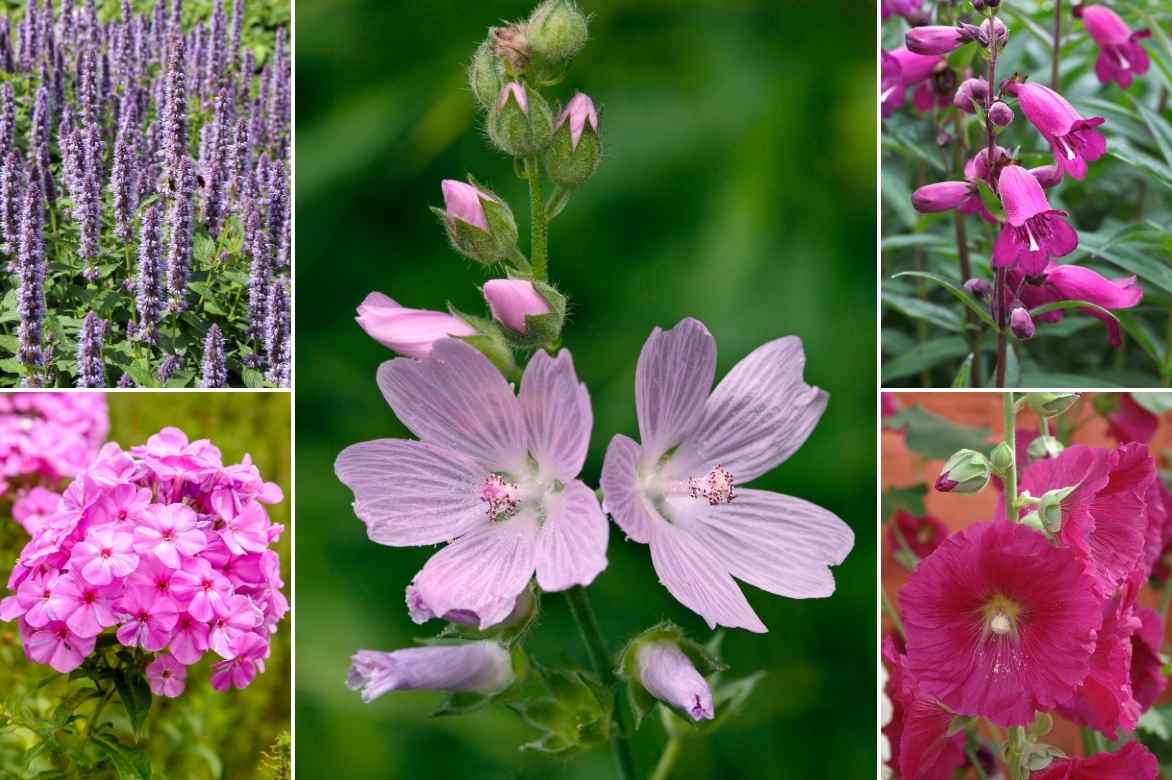
Association of Sidalcea campestris in a pink garden with Agastaches, panicled phlox, Penstemons, and Alcea rosa (hollyhocks)
In a romantic scene, it makes an excellent partner for old roses in pastel shades.
It will add a colourful touch as punctuation in a summer perennial border, alongside Japanese anemones, perennial delphiniums, hybrid mulleins like Verbascum ‘Rosie’, and ferns. In a country mixed border, it will blend with cosmos, annual poppies, Achillea millefolium ‘Red Velvet’, Achillea ‘Apfelblut’, or ‘Cerise Queen’, and centauries. Their spikes laden with flowers will be beautifully highlighted as they emerge among these bushy perennials.
In flowerbeds, it will neighbour dianthus, Astrantia major ‘Alba’ or ‘Rosensinfonie’, and ornamental garlic.
In pots, plant at its base, perennial snapdragons like Antirrhinum majus ‘Pretty in Pink’.
Useful resources
- Discover our range of vicar’s garden perennials and a selection of perennials and biennials for vicar’s garden
- Draw from the large family of Malvaceae to create a mauve inspiration in the garden!
- Subscribe!
- Contents


































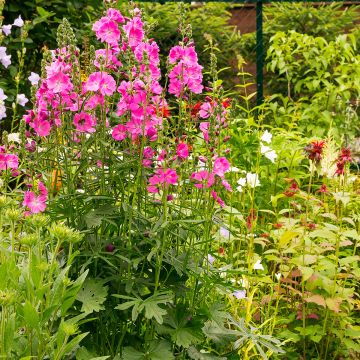
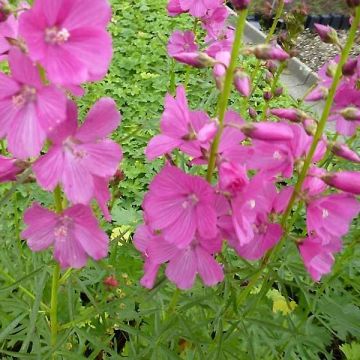


Comments